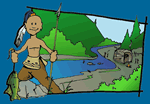


Geography and Landforms:
Utah is bordered by Idaho and Wyoming on the north and by Arizona on the south. On the east, Utah is bordered by Colorado. On the west, Utah is bordered by Nevada.
|
 History:
The first Europeans to enter what is now the state of Utah were Mexicans and Spaniards. In 1540, Garcia Lopez de Cardenas may have entered southern Utah and in 1765, Juan Maria Antonia Rivera may have led at least two expeditions into the area. It is most commonly believed, however, that the region was first explored in 1776 by Spanish Franciscan friars Silvestre Velez de Escalante and Francisco Atanasio Dominguez. They were looking for a route between Santa Fe and Monterey, California. During their travels, they visited with the Ute Indians, but early snow storms forced them to return to Santa Fe before completing their trip. Before they left the area, they made detailed maps, and they drew pictures of plant and animal life, geography, and the appearance of the Ute and Paiute Indians. In 1819, a treaty between the United States and Spain recognized Utah as a Spanish possession. Utah remained under Spanish control until after the Mexican American War in 1848.
|
 Economy:
Although the land in Utah is not particularly well-suited to farming overall, the original settlers of the state, the Mormons, were determined to use the land for agriculture. They also hoped that the difficulties of successfully farming this arid land would discourage others from settling in the area. Major crops grown today in Utah include hay, corn, barley and wheat, but the majority of the state's agricultural income comes from livestock including sheep, cattle, dairying and poultry.
|
 First Inhabitants:
Archaeologists call the first people who lived in the area we now call Utah Paleo-Indians. They were hunters and gatherers who hunted big game, including some animals now extinct, like mammoth. There is evidence across Utah of their lives 10,000 to 12,000 years ago, and this evidence helps us learn more about them. Around 8,000 years ago, there were changes in the way they lived and in the tools they used, and archaeologists call this period the Archaic period. The people still hunted, but they began to settle into small villages or caves, and they were less nomadic. They began to make baskets in which to collect plants to eat. They also began to make stone spear tips so they would be more effective hunters. One tool they began to use was the atlatl, which was used to hurl spears at their prey. This tool made them much more successful at hunting.
|
Books Related To UtahA is for Arches: A Utah Alphabet - Becky Hall The Chihuahua Chase - A.E. Cannon Edges - Lena Roy The Great Brain is Back - John Fitzgerald I am Nuchu - Brenda Stanley Journey Home - Yoshiko Uchida Journey to Topaz: A Story Of The Japanese-American Evacuation - Yoshiko Uchida Keep Sweet - Michele Greene The Maze - Will Hobbs A Place Where Sunflowers Grow - Amy Lee-Tai Samirah's Ride: The Story of an Arabian Filly - Annie Wedekind Sisters in Sanity - Gayle Forman Sweethearts - Sara Zarr The Wheat Doll - Alison Randall |
Famous Citizens:
|
| Capital: | Salt Lake City |
| Entered Union: | January 4, 1896 |
| Population: | 2,942,902 |
| Area | 84,899 |
| Bird | California Seagull |
| Flower | Sego Lily |
| Nickname: | Beehive State |
| Governor | Gary Herbert |
Places to Visit in Utah: (Click the links to learn more.)
|



